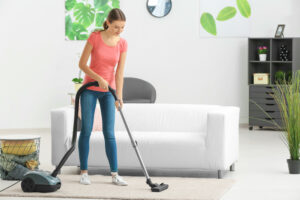 Housekeeping with back pain can be really uncomfortable. Below are some tips for how to move your body while cleaning to minimize pain while vacuuming, dusting, and even doing the dishes. Read below to find out more! For more information on the treatments and services we offer at Prairie Spine, click here.
Housekeeping with back pain can be really uncomfortable. Below are some tips for how to move your body while cleaning to minimize pain while vacuuming, dusting, and even doing the dishes. Read below to find out more! For more information on the treatments and services we offer at Prairie Spine, click here.
Keeping your home livable and tidy can be challenging when you have a chronic low back problem. Along with common sense strategies such as clean as you go whenever possible and organizing your tools ahead of time, getting a handle on good body mechanics can help you manage this regular responsibility—without bringing on back pain symptoms.
To that end, let’s take six common household chores and understand how to perform them in a way that your back will like.
Before we do, though, you should know that implementing the following tips requires a willingness on your part to become aware of the unique way you do each of the individual tasks. Housekeeping-related back troubles usually come about because we don’t take the small amount of time necessary for thinking about how we do the move. That has to change if you are going to protect your back from injury, pain (such as sciatica pain) or re-injury.
Vacuuming
Think that “slouching” is limited only to standing and sitting? Think again. Vacuuming is one of those things that can quickly lead to a habitual bent over posture in your low back. This is not particularly great for your spine’s health; slouching in the low back—whether it’s from a position you hold for a sustained period of time, or an activity, such as vacuuming, that requires repetition—can lead to problems with your intervertebral discs.
Another thing people tend to do is vacuum with an ultra-straight back. Just like the slouching tendency, keeping your spine rigidly over-extended while vacuuming is potentially damaging. In this case, though, it may irritate spinal arthritis-related issues. Or, it can intensify your normal low back curve, which, in turn, may lead to extra tight (and painful) back muscles.
You can go about vacuuming with good body mechanics in one of two ways. (Switching between the two at different times is perfectly okay, and in fact, is recommended.)
The first strategy is to employ a small lunge position that stays in a pain-free zone. In other words, don’t extend your lunge beyond your physical comfort zone. It’s just not worth the risk. For this method, all you need to do is place one foot in front of the other a small distance. (The stance is similar to the way fencers position themselves.) This will allow you to shift forward and back during the vacuuming process, rather than to bend or round over (i.e., slouch) at your spine.
If you have sacroiliac joint issues, you will likely find forward placement of one of your legs (i.e., either right or left) to be more comfortable than forward placement of the other. Don’t work in pain. Use the side that feels comfortable, and stick with that.
Other than that, switching legs and/or arms from time to time may help you avoid muscle fatigue or triggering an injury.
Two other tips for the lunge strategy: Place your non-vacuuming hand on the thigh that’s in front to help take some weight and pressure off your back. Second, try to keep your pelvis in a level position as you work. The second strategy, if you can get up and down from the floor without much trouble, is to vacuum while kneeling on one knee. (Think marriage proposal.) This brings your center of mass closer to the floor, reducing the degree to which your body has to deal with the force of gravity. Kneeling while vacuuming may also help prevent rounding over at the spine, which is a variation of the slouching we talked about above.
Dusting and Polishing
When dusting and polishing furniture, take a load off your back by propping your inactive arm on the item you’re cleaning. Alternatively, you can prop that arm on your thigh.
Doing Laundry
Let’s face it—laundry can be a load! It’s very easy to overdo things with this particular housekeeping task.
If possible, break up the loads you have to lift or carry into small bundles that don’t weigh much. You’ll probably have more loads to deal with that way, but overall this strategy is less likely to offend your spine.
As with vacuuming, try to avoid extremes in spinal position. In other words, don’t round over at your spine, nor keep it rigid and over-extended. The familiar slogan “lift with your legs and not your back” is one that will serve you well here; it is the basis of good body mechanics.
So, if you have a lot of laundry to do, adhere to this piece of advice without fail; otherwise, your discs may be at risk. The only other way we know of to pick up a full laundry basket is to round over at the spine, and as you’ve probably gathered, this is a no-no.
Tweaks you can make to your basic “lift with your leg and not your back” strategy include putting the laundry basket on a table or chair that is preferably the same height as the washer or dryer. This will minimize how much bending you’ll need to do to fill the basket.
And, as with vacuuming and dusting, take the pressure off your back by using one hand to load your washer, dryer or laundry basket, while using the other to prop yourself up on one of the appliances.
Doing the Dishes
Everyone has their favorite and least favorite household chores.
One way to help prevent injury and/or relieve pain during dishwashing is to use a small step stool or box. Place it inside the cabinet under the sink and rest one foot on it.
This strategy may work particularly well if you have a sacroiliac joint problem, especially if the foot on the pain-free side is the one you place on the box or stool. (In other words, as with vacuuming, make sure your foot placement reduces pain and discomfort and doesn’t cause it.)
Using a box or stool in this way may help with core stability, too. Core stability is one of the best ways, in general, to prevent injury and keep low back pain away.2 And it can work in the kitchen as well. Here’s why.
First, the box is located directly under the sink, meaning you’ll likely have to position yourself firmly against the counter. This gives you a modicum of body stability during the activity. Second, to use the box or stool, you’ll be contracting pelvic and hip muscles which, in turn, will likely strengthen your core.
By the way, doing dishes shares key body mechanics with other household chores. The two that come to mind are washing walls and ironing. So use the tips in this section for those tasks, too.
With wall washing and ironing, though, you have an added advantage. You can, for the most part, work with one hand only. This enables you to prop the other arm on the board or wall to help take pressure off your back.
Making the Bed
Making the bed involves bending, reaching, and pressures. Again, it’s important not to slump through your spine nor work with an excessively straight or rigid spine. Monitor your back tension and position and adjust as needed.
If you position yourself up against the bed, you’ll be able to use the bed for support and positional stability. Then use one arm to prop your weight as you reach and work with the other arm. Switch sides regularly unless that causes pain. (It may if you have a sacroiliac joint or other problem that affects one side more than the other.)
If you have a long way to reach across the bed, you might prop up one knee on a pillow on the bed’s surface.
Sweeping and Raking
Many people sweep and rake with their spine. But this strategy—or lack thereof – may be counterproductive to your health.
Instead of overly involving your back in your sweeping and raking, think about using your arms and legs. The idea is to reach and pull the broom with your arms and, rather than twisting around to get into all the directions where the dirt can be found, work with on leg in front of the other. When you need to change directions, pivot on your back leg, keeping your trunk relaxed. If you’ve ever done tai chi, this move may sound familiar.
Or, consider turning your whole body into new directions by taking small steps.
Both methods—taking small steps around or pivoting on your back leg to change the direction your trunk and arms face—save a lot of wear and tear. Both are excellent strategies. Why? Because twisting and bending at the same time is a known risk factor for a herniated disc.3
Here are a few tweaks you can add to your new method for sweeping and raking.
- Sweep or rake about 1 to 2 feet in front of you to avoid overreaching and strain.
- Keep your spine in one long, flexible but unbroken line. In other words, head, shoulders, rib cage, pelvis, knees and feet should always face the same direction and should all be balanced vertically relative to one another. (As discussed above, this will probably mean you’ll need to change directions either by pivoting on your back leg or to move your whole body around by taking small steps.)
- Consider an ergonomically designed broom or rake; this will likely be one that has a bend in the stem to help you avoid bending in your spine.
Housekeeping With Good Body Mechanics Is a System
When you think about it, most of the ergonomic tips for housekeeping tasks revolve around the same ideas: Keep your spine neutral, avoid twisting where ever possible, find and develop core support and don’t overdo it.
And, if you love to garden, the good body mechanics system works well for those tasks, too.
Complete and original article published on verywellhealth.com







